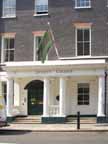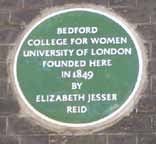The "junior departments" of the University of London's founding colleges were only for boys; it was not until 1848 that any provision was made for girls. This was when F. D. Maurice and his colleagues at King's founded Queen's College in Harley Street, under the auspices of the recently established Governesses' Benevolent Institution (Roberts and Falkenberg 23). Five years later, the Unitarian philanthropist Elisabeth Jesser Reid was so dismayed by the level of entrants to her new "Ladies' College" near the British Museum that she too opened a girls' school on its Bedford Square premises. Both schools were pioneering establishments, but only Queen's College continues to flourish today.


Left: Queen's College School, Main Entrance. Right: Queen's College School, Plaque. [Click on thumbnaails for larger images.]
From the start, Queen's College was open to all girls over the age of twelve; soon preparatory and evening classes were offered as well. Maurice disapproved of competition, and was not in favour of either rewards or punishments, so it was run very much along the lines of a regular college. Under the watchful eye of women chaperones, the girls attended lectures and submitted essays in the subjects of their choice. The duty of chaperoning was undertaken by some of the great blue-stockings of the day, like Lady Kay-Shuttleworth, wife of the education reformer ("a small, energetic woman," Uglow 248) and Lady Henrietta Maria Stanley, who would be important in the establishment of Girton College Cambridge. Such chaperones must have enjoyed sitting in on the classes of eminent people: Charles Kingsley was the first Professor of English Literature and Composition there, and Maurice himself lectured there, serving as Professor of English Literature and Modern History from 1858 to1866. By this time Queen's College had already received its Royal Charter. Granted in 1853, this was "the first charter ever granted by an English sovereign for the furtherance of women's education" (School Prospectus); it marked the independence of the college from the Governesses' Benevolent Institution. The first principal of the college, Arthur Penrhyn Stanley, Dean of Westminster, was appointed in 1864.


Left: Staircase with Maurice's portrait, Queen's College School. Right: Another interior view of Queen's. [Click on the thumbnails for larger images.]
Queen's College issued its own certificates of proficiency, and although it was possible to take a University of London degree, few did so. In this way, it evolved into what it is today, an excellent girls' school. Not only the pioneering educationists Miss Buss and Miss Beale, but also the authors Gertrude Bell and Katherine Mansfield, were once pupils. A portrait of Maurice still looks down on the entrance hall from above the main stairway; to the right of the front entrance, a smaller stairway gives a hint of the gracious days whose atmosphere still pervades the school. Part of a facsimile of the Royal Charter hangs over these narrower stairs. The school continues to enjoy Royal patronage.
Left: The original premises of the Ladies' College on Bedford Square. Right: Bedford College, Plaque. [Click on thumbnaails for larger images.]
The "Ladies' College" in Bedford Square was founded only a year after Queen's College, the differences between the two colleges to some extent replicating the old rivalry between King's and University College (Harte 112). Queen's itself was not exactly orthodox (Hearnshaw 196), but Elisabeth Reid aimed to establish an institution for women quite "free from Anglican influence and open to dissenters and others" (Ashton 27). With support from strong-minded women like Fanny Wedgwood and Harriet Martineau, she harnessed the services of a galaxy of teachers from University College, including the physiologist William B. Carpenter and the mathematician and logician Augustus De Morgan. The school department was opened in 1854, perhaps with the success of Queen's in mind. But the Bedford Square establishment only ran a junior department for about fifteen years. After Reid's death in 1866 the trustees decided to put all available resources into the college itself. The school was sacrificed in 1868, and the headmistress, a Miss Frances Martin, retired. The college was put on a new footing under the name of Bedford College, and eventually incorporated into the University of London in 1900. Links between its short-lived school and the University of London are therefore very tenuous.
However, the story does not end there. One of the other teachers at the school, Lucy Harrison, who had studied at the Ladies' College herself and was a friend of the feminist Octavia Hill, tried to carry on the enterprise independently. She became a partner in the newly named Gower Street School (Roberts and Falkenberg 23), and its headmistress from 1875-85. In the 1881 Census (now online) Lucy Harrison appears at that address as "Governess (Private) (Prof)," together with one resident teacher and three domestic staff. This need not mean that her establishment was very small: there would have been a plentiful supply of non-residential teachers in the Bloomsbury heartland. Indeed, Elizabeth Morse says that the school flourished, and acquired an "excellent academic reputation" under Harrison's leadership. One of her pupils there was the Bloomsbury-born poet, Charlotte Mew, who formed an intense attachment to her. Like other such establishments in that area (where Dickens's mother had once unsuccessfully tried to take in pupils), the Gower Street School did eventually drop from view.
Although Bedford College had many illustrious alumnae, its name was submerged by its amalgamation with Royal Holloway College in 1985. On the other hand, as detailed above, Queen's College is thriving in its role as an independent school; in 2002 it opened a preparatory school for younger girls in nearby Portland Place. It is rightly proud of its pioneering role in women's education. Perhaps it is a shame that the Ladies' College abandoned its junior department, which might have borne the name of Bedford College into the future.
Related Material
Sources
Ashton, Rosemary. 142 Strand: A Radical Address in Victorian London. London: Chatto & Windus, 2006.
Fitzgerald, Penelope. "Mew, Charlotte Mary (1869-1928)." Oxford Dictionary of National Biography. Online ed. Viewed 3 May 2007.
Harte, Negley. The University of London, 1836-1986: An Illustrated History. London: Athlone Press, 1986.
Hearnshaw, F. J. C. The Centenary History of King's College London, 1828-1928. London: Harrap, 1929.
Morse, Elizabeth. "Harrison, Lucy (1844-1915)." Oxford Dictionary of National Biography. Online ed. Viewed 13 April 2007.
"Queen's College, Harley Street (fn.7)," "A History of the County of Middlesex, Vol. I, pp.311-12 . Viewed 20 May 2007.
Queen's College Prospectus, 2007.
Roberts, Andrew and Betty Falkenberg. " Charlotte Mew Chronology with Mental, Historical and Geographical Connections.... (a Middlesex University resource)." Viewed 5 May 2007.
Uglow, Jenny. Elizabeth Gaskell: A Habit of Stories. London: Faber, 1993.
Last modified 5 April 2016

